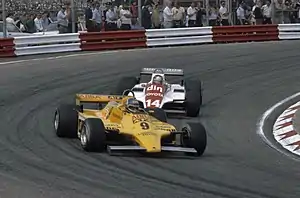ATS D5
The ATS D5 was a Formula One racing car manufactured and raced by the Team ATS racing team during the 1981 and 1982 Formula One seasons. Originally known as the HGS1 for the 1981 season, it was updated for 1982 and designated the D5. It was powered by the Ford Cosworth DFV V8. The team scored five points with the D5 across the two seasons it was raced.
 Slim Borgudd driving the ATS D5 at the 1981 Dutch Grand Prix | |||||||||
| Category | Formula One | ||||||||
|---|---|---|---|---|---|---|---|---|---|
| Constructor | ATS | ||||||||
| Designer(s) | Hervé Guilpin Tim Wadrop Don Halliday | ||||||||
| Predecessor | ATS D4 | ||||||||
| Successor | ATS D6 | ||||||||
| Technical specifications[1] | |||||||||
| Chassis | Aluminium monocoque | ||||||||
| Axle track | Front: 1,826 mm (71.9 in) Rear: 1,727 mm (68.0 in) | ||||||||
| Wheelbase | 2,718 mm (107.0 in) | ||||||||
| Engine | Ford Cosworth DFV, 2,993 cc (182.6 cu in), 90° V8, NA, mid-engine, longitudinally mounted | ||||||||
| Transmission | Hewland FGA 400 5-speed manual | ||||||||
| Weight | 585 kg (1,290 lb) | ||||||||
| Fuel | Shell | ||||||||
| Tyres | Michelin/Avon | ||||||||
| Competition history | |||||||||
| Notable entrants | Team ATS | ||||||||
| Notable drivers | |||||||||
| Debut | 1981 Belgian Grand Prix | ||||||||
| |||||||||
| Constructors' Championships | 0 | ||||||||
| Drivers' Championships | 0 | ||||||||
Development
The D5, originally designated the HGS1, was designed by Hervé Guilpin and Tim Wadrop.[1] The HGS1 chassis was updated by Don Halliday for the 1982 season, for which it was known as the D5.[2] It utilised an aluminium monocoque and was powered by a Ford Cosworth DFV V8.[1]
Racing history
The D5, known initially as the HGS1, made its first appearance partway through the 1981 Formula One season at the Belgian Grand Prix, where it was driven by Slim Borgudd. However, he failed to qualify for the race as well as the following two events. At the British Grand Prix he qualified in 21st and then on went on to finish sixth.[1] This proved to be Team ATS's only point of the year.
Team ATS continued to use the HGS1, modified by Don Halliday[2] and now designated as the D5, for the 1982 Formula One season. Manfred Winkelhock joined the team as a replacement for Borgudd and Eliseo Salazar was the second driver. The pair started the season with promise, finishing 9th and 10th in South Africa and Winkelhock then finished fifth at the Brazilian race for two points.[1] Salazar finished fifth at Imola although this race saw a reduced field of entrants due to a boycott by most of the FOCA aligned teams.[2]
No further points were scored for the remainder of the season. The drivers would generally qualify towards the rear of the field although Winkelhock did start the United States Grand Prix from fifth on the grid. Reliability was often an issue with several retirements due to mechanical failures. There was the odd driver error,[1] notably when Salazar collided with Brabham's Nelson Piquet at the 1982 German Grand Prix.[3]
Complete Formula One World Championship results
(key)
| Year | Entrant | Chassis | Engine | Drivers | 1 | 2 | 3 | 4 | 5 | 6 | 7 | 8 | 9 | 10 | 11 | 12 | 13 | 14 | 15 | 16 | Points | WCC |
|---|---|---|---|---|---|---|---|---|---|---|---|---|---|---|---|---|---|---|---|---|---|---|
| 1981 | Team ATS | HGS1 | Ford DFV V8 | USW | BRA | ARG | SMR | BEL | MON | ESP | FRA | GBR | GER | AUT | NED | ITA | CAN | CPL | 1 | 12th= | ||
| Slim Borgudd | DNQ | DNPQ | DNQ | DNQ | 6 | Ret | Ret | 10 | Ret | Ret | DNQ | |||||||||||
| Jan Lammers | DNE | DNE | ||||||||||||||||||||
| 1982 | Team ATS | D5 | Ford DFV V8 | RSA | BRA | USW | SMR | BEL | MON | DET | CAN | NED | GBR | FRA | GER | AUT | SUI | ITA | CPL | 4 | 11th | |
| Manfred Winkelhock | 10 | 5 | Ret | DSQ | Ret | Ret | Ret | DNQ | 12 | DNQ | 11 | Ret | Ret | Ret | DNQ | NC | ||||||
| Eliseo Salazar | 9 | Ret | Ret | 5 | Ret | Ret | Ret | Ret | 13 | DNQ | Ret | Ret | DNQ | 14 | 9 | DNQ |
References
- ATS D5 @ StatsF1
- Nye 1985, p. 164.
- Henry 1985, p. 251.
Bibliography
- Henry, Alan (1985). Brabham: The Grand Prix Cars. Richmond, Surrey, United Kingdom: Hazelton Publishing. ISBN 0905138368.CS1 maint: ref=harv (link)
- Nye, Doug (1985). Autocourse History of the Grand Prix Car 1966–1985. Richmond, Surrey, United Kingdom: Hazelton Publishing. ISBN 0905138376.CS1 maint: ref=harv (link)
